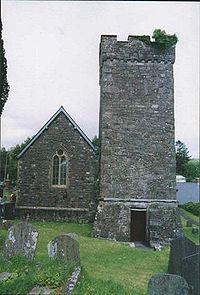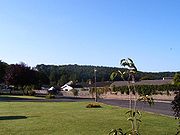
Llanllwch
Encyclopedia

Hamlet
The Tragical History of Hamlet, Prince of Denmark, or more simply Hamlet, is a tragedy by William Shakespeare, believed to have been written between 1599 and 1601...
in Wales
Wales
Wales is a country that is part of the United Kingdom and the island of Great Britain, bordered by England to its east and the Atlantic Ocean and Irish Sea to its west. It has a population of three million, and a total area of 20,779 km²...
approximately two miles west of Carmarthen
Carmarthen
Carmarthen is a community in, and the county town of, Carmarthenshire, Wales. It is sited on the River Towy north of its mouth at Carmarthen Bay. In 2001, the population was 14,648....
.
History
The name Llanllwch derives from a lake or pool nearby, the site of which is now a tract of boggy land west of Llanllwch known as Llanllwch bog.St Mary's Church, Llanllwch
St Mary's Parish Church was originally a chapel attached to St Peter's Church, both of which were conferred on the Priory of St. John the Evangelist at Carmarthen in the early Middle AgesMiddle Ages
The Middle Ages is a periodization of European history from the 5th century to the 15th century. The Middle Ages follows the fall of the Western Roman Empire in 476 and precedes the Early Modern Era. It is the middle period of a three-period division of Western history: Classic, Medieval and Modern...
. The church's original tower probably dates from the fifteenth century, while the rest of the church has been built and rebuilt since then.
One of the monuments in the church is in memory of John Vaughan of Court Derllys (Died 1722) who in his lifetime contributed largely towards the building of this chapel, and industriously promoted the same charitable disposition in others. The church was restored again in 1862 and 1865 when eisteddfodau in aid of the restoration fund were held in Carmarthen's market place.
Edwardes Family
St Mary's church was the place of worship of the ancient Edwardes family of Rhyd-y-gorsRhyd-y-gors
The name Rhyd-y-gors or Rhydygors has been associated with two historic sites near the market town of Carmarthen in Southwest Wales. The first was the Norman Rhyd-y-gors Castle and the other was Rhyd-y-gors Mansion, home of the Edwardes family....
.
Two marble monuments (pictured right) commemorate various members of the Edwardes family, who are interred in the family vault beneath. One dates from 1786, when Thomas Edwardes was buried there. Captain David John Edwardes 1787-1866 and his son Captain Frederick Augustus Edwardes 1829-1878 are buried in the churchyard behind the church.

The Parish of Llanllwch
The Parish of Llanllwch was originally a part of the historic Parish of St. Peter, which was divided into three districts by an Order of the Queen in Council dated 10 November 1843, whichn in July 1857 became separate parishes. The Borough of carmarthen ceased to exist after the local government reorganization of 1974, but Llanllwch still remains within the authority of Carmarthen Town Council.The Manor of Llanllwch
The Llanllwch area formed part of the royal demesne manor of Carmarthen Castle between Norman times and the late thirteenth century when they were farmed out for rent to 'customary' tenants called "gabblers" (gabularii) or "gafol-men", who were still tied to the castle. Other areas were let to local landowners. Eleven of the twelve gafol-men died from the Black DeathBlack Death
The Black Death was one of the most devastating pandemics in human history, peaking in Europe between 1348 and 1350. Of several competing theories, the dominant explanation for the Black Death is the plague theory, which attributes the outbreak to the bacterium Yersinia pestis. Thought to have...
between 1349 and 1350 and the other tenants abandoned their land, leaving the area uncultivated. There were also several water mills for grinding corn, one of which was documented in 1300. The hamlet and the mills were "totally destroyed and devastated" according to acoounts of 1407-09 during the rebellion of Owain Glyn Dwr.

Cors Goch
West of Llanllwch lies Cors Goch, a lowland raised mire and one of the last six large raised bogs in Wales, and a Site of Special Scientific InterestSite of Special Scientific Interest
A Site of Special Scientific Interest is a conservation designation denoting a protected area in the United Kingdom. SSSIs are the basic building block of site-based nature conservation legislation and most other legal nature/geological conservation designations in Great Britain are based upon...
(SSSI).

